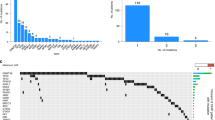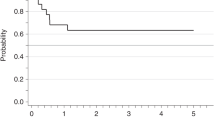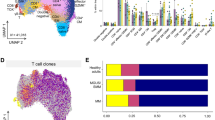Abstract
We report a case of a patient with IgA κ multiple myeloma (MM) mobilized with etoposide and subsequently receiving high-dose melphalan (HDM) with stem cell support. She relapsed rapidly post transplantation. Southern blot and fluorescent in situ hybridization analysis showed MLL gene rearrangement in the myeloma cells, which was not detected in the sample at diagnosis or in the PBSC harvested with etoposide plus G-CSF. These observations suggest that clonal rearrangement of the MLL gene is caused by etoposide. Patients with MM undergoing HDM with stem cell rescue may be at an increased risk of not only secondary leukemia, but also secondary genetic abnormalities in myeloma cells, especially those receiving priming with etoposide for peripheral blood stem cell collection. Bone Marrow Transplantation (2001) 27, 555–558.
This is a preview of subscription content, access via your institution
Access options
Subscribe to this journal
Receive 12 print issues and online access
$259.00 per year
only $21.58 per issue
Buy this article
- Purchase on Springer Link
- Instant access to full article PDF
Prices may be subject to local taxes which are calculated during checkout




Similar content being viewed by others
References
Lenhoff S, Hiorth M, Holmberg E et al. Impact on survival of high-dose therapy with autologous stem cell support in patients younger than 60 years with newly diagnosed multiple myeloma: a population-based study Blood 1999 95: 7–11
Copelan EA, Ceselski SK, Ezzone SA et al. Mobilization of peripheral-blood progenitor cells with high-dose etoposide and granulocyte colony-stimulating factor in patients with breast cancer, non-Hodgkin's lymphoma, and Hodgkin's disease J Clin Oncol 1997 15: 759–765
Boiron JM, Marit G, Faberes C et al. Collection of peripheral blood stem cells in multiple myeloma following single high-dose cyclophosphamide with and without recombinant human granulocyte–macrophage colony-stimulating factor (rhGM-CSF) Bone Marrow Transplant 1993 12: 49–55
Pedersen-Bjergaard J, Andersen MK, Christiansen DH . Therapy-related acute myeloid leukemia and myelodysplasia after high-dose chemotherapy and autologous stem cell transplantation Blood 2000 95: 3273–3279
Stone RM . Myelodysplastic syndrome after autologous transplantation for lymphoma: the price of prognosis Blood 1994 83: 3437–3440
Krishnan A, Bhatia S, Slovak ML et al. Predictors of therapy-related leukemia and myelodysplasia following autologous transplantation for lymphoma: an assessment of risk factors Blood 2000 95: 1588–1593
Bhatia S, Robinson LL, Oberlin O et al. Breast cancer and other second neoplasms after childhood Hodgkin's disease New Engl J Med 1996 334: 745–751
Andrieu JM, Ifrah N, Payen C et al. Increased risk of secondary acute nonlymphocytic leukemia after extended-field radiation therapy combined with MOPP chemotherapy for Hodgkin's disease J Clin Oncol 1990 8: 1148–1154
Super MJ, McCabe NR, Thirman NJ et al. Rearrangements of the MLL gene in therapy-related acute myeloid leukemia in patients previously treated with agents targeting DNA-topoisomerase II Blood 1993 82: 3705–3711
Zhang Y, Poestch M, Weber-Matthiesen K et al. Secondary acute leukemias with 11q23 rearrangement: clinical, cytogenetic, FISH and FICTION studies Br J Haematol 1996 92: 673–680
Pedersen-Bjergaard J, Philip P, Larsen SO et al. Therapy-related myelodysplasia and acute myeloid leukemia. Cytogenetic characteristics of 115 consecutive cases and risk in seven cohorts of patients treated intensively for malignant disease in Copenhagen series Leukemia 1993 7: 1975–1986
Taniwaki M, Nishida K, Ueda Y, Takashima T . Non-random chromosomal rearrangements and their implications in clinical features and outcome of multiple myeloma and plasma cell leukemia Leuk Lymphoma 1996 21: 25–30
Acknowledgements
This work was supported by a Grant-in-Aid (1998) from the Mie Medical Research Foundation.
Author information
Authors and Affiliations
Rights and permissions
About this article
Cite this article
Nishii, K., Katayama, N., Chen, F. et al. Aggressive neoplastic plasma cell growth with MLL gene rearrangement after high-dose therapy with autologous stem cell support for multiple myeloma. Bone Marrow Transplant 27, 555–558 (2001). https://doi.org/10.1038/sj.bmt.1702817
Received:
Accepted:
Published:
Issue Date:
DOI: https://doi.org/10.1038/sj.bmt.1702817



